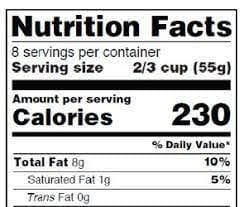Are Food Labels Misleading?

Every company wants to sell its product, whether a beverage, food, or fashion company. Sometimes, to persuade customers, companies make promises that are often misleading.
How does that happen?
Companies usually label products as sugar-free, vegan, low-fat, etc. These health claims are usually just to attract health-conscious customers. Dissecting and understanding food labels is challenging. If you're unfamiliar with food terms, you might feel compelled to buy the product.
Public Health Nutrition published a study in 2022 that shed light on this topic. Researchers conducted two experiments to analyze customers' understanding of whole grains on food labels. Half of the 1,000 adults in this study mistook healthy options for the 'better' ones.
A dishonest food label has a direct negative impact on the brand's image. However, not many people know this can lead to permanently suspending business. Let's dive deeper into this topic and understand whether food labels are misleading.
Why Are Food Labels Important?
Labels are important because they concisely inform the customer about the product. When a customer purchases a food product, they first view the label. The label ensures that the product is safe to use and store. It's also a legal requirement that every company comply with.
Food labels are generally on the package's front, back, or side. The details usually include warnings, allergy information, nutritional facts, manufacturing date, expiry date, etc. What's the significance?
It helps customers make healthy choices in life. However, due to misleading food labels, companies often face lawsuits and are banned from operating again. However, if you provide the necessary information, you can minimize cases like this.
Let's understand it better with an example.
Sam is a busy office worker who goes grocery shopping after a long day at work. He's looking for a quick and healthy dinner option, so he picks two different frozen meals from the store shelves.
- Vegetable stir fry
- Chicken alfredo pasta
But before purchasing the product, he takes a moment to read the food labels on both packages.

Source: fda
He notices that vegetable stir-fry has fewer calories, less saturated fat, and more fiber than the chicken Alfredo pasta. Furthermore, he checks the ingredients list and finds that the stir-fry contains only natural ingredients.
On the other hand, pasta sauce contains added preservatives and flavorings. Considering his health goals, Sam decides to go with the vegetable stir-fry. That's how you can inform the customers and encourage them to purchase the product.
Why Are Food Labels Misleading?
Now, let's answer the most burning question: are food labels misleading?
Manufacturers often make misleading information and claims. It's a part of their sales strategy to grab customers' attention so they buy products. During COVID-19, companies noticed an increase in health-conscious customers. So, they found a perfect way to use this opportunity in their favor. They overstate their products' benefits to create a facade of how good their product is.
According to a study, more than 45% of customers are worried that brands that claim to be healthy are not. Meanwhile, 41% expressed concern that the ingredients aren't scientifically proven to have any health benefits.
It introduces us to another technique used by food marketers: deceptive marketing. In 2022, more than 200 lawsuits were filed against companies using these tactics. Here are some common examples of misleading labels with attractive language to grab customers.
- All Natural: It implies natural ingredients but lacks a standardized definition. Thus allowing for artificial additives.
- Organic: Indicates pesticide-free, but doesn't guarantee nutritional quality or absence of unhealthy ingredients.
- Gluten-Free: Essential for some individuals. It doesn't inherently mean healthier or lower in calories.
- Made with Real Fruit: Often contains minimal fruit content, with artificial additives as main ingredients.
- Low Fat or Fat-Free: May still be high in sugar or additives, leading to unintended calorie intake.
5 Important Food Labeling Guidelines You Should Know
If you're selling packed or sealed food or any product in general, you must follow certain rules and regulations. It'll ensure that your food label isn't against any legal requirements. Here are five important food labeling guidelines you should know.
Add Food Identity In Package Form
You must add the original form of your food on the product label. Every food has different forms, such as slices, gratings, and dicing. You must include the common name at the front of the packaging's principal display panel (PDP).
Let's understand it with an example.

Source: linkedin
Lays isn't a form of food. Instead, it's the name of a snack's product. That's why companies should list themselves as "Potato Chips," which is their core identity. Whenever a customer purchases a product, they look at the PDP to learn more about it.
Add Detailed Information About Involved Authorities
You should add detailed information about your product. From manufacturers to shippers, packers to distributors, add data on the labels. This information is present on the right side of the PDP.
But what if a corporation is the actual owner of the product? In that case, you only need to add the corporate name on the front side of the packaging.
However, the criteria are different for individuals, partnerships, or associations. They should use the name in which the business is held. If an individual doesn't manufacture the product, it's important to provide details.
Include phrases such as manufactured by and add the company's name. Use this same strategy for adding information on the label. In addition to the name, you should also add a place of business, street address, city, and ZIP code. This information is present in the information panel section.
Declare All Ingredients Present
Many people don't know, but the package ingredients should be declared in descending order with respect to weight. This information appears separately under the nutrition panel.
But what if there's a lack of space?
In that case, it is placed on the right side. First, mention the ingredients and then all the ingredients' names. Make sure that all the sub-ingredients are written down in parentheses.
Net Quantity Of Contents
The detailed information about food is found on the PDP label. Ensure it's expressed in weight, fluid measure, count, or a combination. The term Net Weight is often used for this.
This section clearly states the product's total weight. However, the packaging weight is not included.
Nutrition Facts And Information
Nutrition information informs consumers about the nutritional composition of products. It includes vitamins, minerals, sugar content, etc. This section is on the PDP or the information panel near the ingredient declaration.
Remember that the US Food and Drug Administration (FDA) governs this. According to the FDA, the nutrition facts should include serving size, household unit, and servings per container. Some mandatory nutrients include iron, protein, cholesterol, calcium, sodium, potassium, vitamin D, total and added sugars, dietary fiber, calories, carbohydrates, fat, trans fat, and saturated fat.

Source: cdn
From a customer's perspective, understanding food labels is a troublesome task. For starters, you should check the ingredients list, serving sizes, and the front of the packaging.
Why Should Companies Avoid Making Misleading Food Labels?
Now that you have a clear idea about misleading food labels, you might wonder:
Why should you not use misleading food labels? You're getting customers. Isn't that what's needed to run a successful business?
Yes. Client attraction is important. However, misleading food labels have tons of disadvantages. Here are some of the most common that you must know.
- Legal Liability: Companies that use misleading labels may face legal consequences. It includes fines and lawsuits if they are found to violate food labeling regulations.
- Ethical Considerations: Using misleading labels is unethical and can harm consumers. Especially those who rely on accurate information to make informed choices about food purchases.
- Consumer Health and Safety: Misleading labels can harm consumer health and safety. If they fail to disclose allergens or other potential hazards accurately,
- Reputation Damage: These can damage a company's reputation and consumer trust. Once consumers discover that a company has misled them, they are less likely to purchase products from that company.
To Sum Up
It's the need of the hour to attract customers and increase sales. But remember that it should never be at the expense of your customer's health and well-being.
Every food manufacturer must follow various food rules and regulations. It helps them avoid legal action and operate smoothly. It's their responsibility to make levels that are honest and legible. It should never create problems for the customers.
Still confused about what your next step should be?
Then Altro Labels is here to assist you and provide relevant information about your food label. Connect with us today to start your journey of making attractive labels for your food products.
